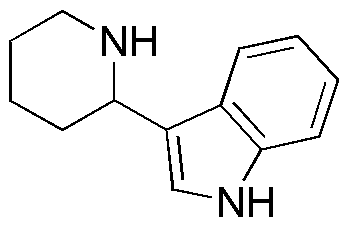3-Piperidin-2-yl-1H-indole is widely utilized in research focused on:
- Pharmaceutical Development: This compound serves as a crucial building block in the synthesis of various pharmaceuticals, particularly in the development of drugs targeting neurological disorders due to its ability to interact with specific receptors in the brain.
- Biological Research: Researchers use it to study its effects on cellular pathways and its potential as a therapeutic agent, making it valuable in the fields of biochemistry and molecular biology.
- Material Science: It is applied in the development of novel materials, including polymers and coatings, where its unique chemical structure can enhance material properties such as durability and resistance to environmental factors.
- Agrochemicals: The compound is explored for its potential use in agrochemicals, particularly as a pesticide or herbicide, offering a more targeted approach to pest control compared to traditional chemicals.
- Diagnostics: It is being investigated for use in diagnostic applications, where its properties may aid in the development of new assays or imaging techniques that improve disease detection.
General Information
Properties
Safety and Regulations
Applications
3-Piperidin-2-yl-1H-indole is widely utilized in research focused on:
- Pharmaceutical Development: This compound serves as a crucial building block in the synthesis of various pharmaceuticals, particularly in the development of drugs targeting neurological disorders due to its ability to interact with specific receptors in the brain.
- Biological Research: Researchers use it to study its effects on cellular pathways and its potential as a therapeutic agent, making it valuable in the fields of biochemistry and molecular biology.
- Material Science: It is applied in the development of novel materials, including polymers and coatings, where its unique chemical structure can enhance material properties such as durability and resistance to environmental factors.
- Agrochemicals: The compound is explored for its potential use in agrochemicals, particularly as a pesticide or herbicide, offering a more targeted approach to pest control compared to traditional chemicals.
- Diagnostics: It is being investigated for use in diagnostic applications, where its properties may aid in the development of new assays or imaging techniques that improve disease detection.
Documents
Safety Data Sheets (SDS)
The SDS provides comprehensive safety information on handling, storage, and disposal of the product.
Product Specification (PS)
The PS provides a comprehensive breakdown of the product’s properties, including chemical composition, physical state, purity, and storage requirements. It also details acceptable quality ranges and the product's intended applications.
Certificates of Analysis (COA)
Search for Certificates of Analysis (COA) by entering the products Lot Number. Lot and Batch Numbers can be found on a product’s label following the words ‘Lot’ or ‘Batch’.
*Catalog Number
*Lot Number
Certificates Of Origin (COO)
This COO confirms the country where the product was manufactured, and also details the materials and components used in it and whether it is derived from natural, synthetic, or other specific sources. This certificate may be required for customs, trade, and regulatory compliance.
*Catalog Number
*Lot Number
Safety Data Sheets (SDS)
The SDS provides comprehensive safety information on handling, storage, and disposal of the product.
DownloadProduct Specification (PS)
The PS provides a comprehensive breakdown of the product’s properties, including chemical composition, physical state, purity, and storage requirements. It also details acceptable quality ranges and the product's intended applications.
DownloadCertificates of Analysis (COA)
Search for Certificates of Analysis (COA) by entering the products Lot Number. Lot and Batch Numbers can be found on a product’s label following the words ‘Lot’ or ‘Batch’.
*Catalog Number
*Lot Number
Certificates Of Origin (COO)
This COO confirms the country where the product was manufactured, and also details the materials and components used in it and whether it is derived from natural, synthetic, or other specific sources. This certificate may be required for customs, trade, and regulatory compliance.


